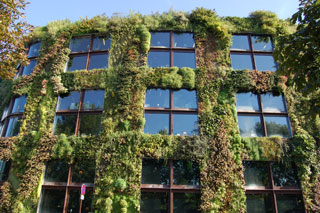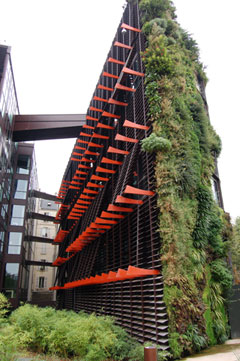Human Flower Project
Wednesday, September 20, 2006
Hanging Gardens of Paris
It’s not Babylon, but better—Two wonders of vertical gardening in the City of Light.

Le mur végétal, at Musée du Quai Branly
Photo: Julie Ardery
You’d know us for tourists, what with the pointing, the constant unfolding of a plastic map, and the very unsexy problems with masculin et feminin. We are also the ones unabashedly looking up, the better to see two marvelous Parisian gardens that hang in the sky.
One covers a part of the new and controversial Musée du Quai Branly, the house Chirac built for $293 million. The museum, which opened in June, brings together objects once called “primitive art”—African drums, Northwest Indian totem poles, embroidery from Thailand, Mesoamerican stone carvings—all those things that are neat to look at but for reasons yet unclear can’t make the cut into the Louvre. (More on this later.)
 Patrick Blanc’s Vegetal Wall
Patrick Blanc’s Vegetal Wall
at Le Musée du Quai Branly
Photo: Bill Bishop
The Quai Branly museum buildings, designed by Jean Nouvel, are stunning, no matter what one may think of what goes on inside. A commentator writes, “Geometric shapes meet flowing curves; plate glass meets natural wood; concrete meets vegetation. Detractors lament the architectural medley. But the overall result is oddly harmonious, perhaps because of the linking theme of nature. Once the trees planted on it mature, the site will be shaded and woodlike. There is even an extraordinary 800-square-metre ‘vegetation wall’: a vertical garden in which 150 different plant species have taken root on polyamide felt, stapled to waterproof PVC slabs and fed by automatic hosepipes.”
Le mur végétal covers the north facade of the museum’s offices. We learned that botanist Patrick Blanc, who was called in for the project, has created other growing walls, in Japan and the United Arab Emirates. For the Musée du Quai Branly he chose 15,000 plants from China, the U.S., Central Europe, and Japan, and like a tapestry artist, has woven them together: a tall green, cool, and fuzzy “garden” suspended next to brown metals, gray stone, and pavement. Blanc found inspiration in woodland plants that grow on rocks and tree trunks, and as you’d guess, many of the specimens in his upright garden are of the mossy and ferny sort, though we did see a few red blooms. Springtime may be another story.
Across town in the Jussieu neighborhood, we happened upon another hanging garden, less celebrated, but to our eye just as beautiful. Someone has affixed an armature subtly below the Ecole Polytechnique (perhaps fulfilling an assignment for Introductory Engineering). All around a carved niche, greenery cascades and petunias, geraniums, begonias, and other popular annuals bloom. Above a little park where children knocked a soccer ball and sweethearts embraced on benches, this hanging garden made a shady glen. On closer inspection, we could see that each plant grew from a tiny pot (which as any gardener knows means daily or twice daily watering in June, July, August). Parisians don’t wear hats but we do and will doff ours to the anonymous gardener who nursed this garden through the summer heat wave, so that it could reach such dense splendor with fall coming on.

Hanging garden, outside the Ecole Polytechnique, Paris
Photo: Julie Ardery
Some proto-Frommer called the Hanging Gardens of Babylon one of the Seven Wonders of the World. That’s only hearsay, though: no contemporary ever described them. It’s a bigger world now.
Ergo, we keep on gawking.




